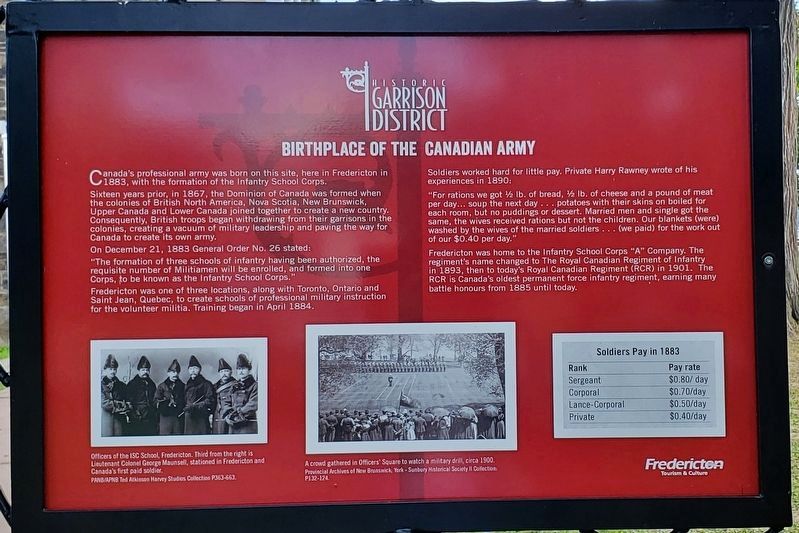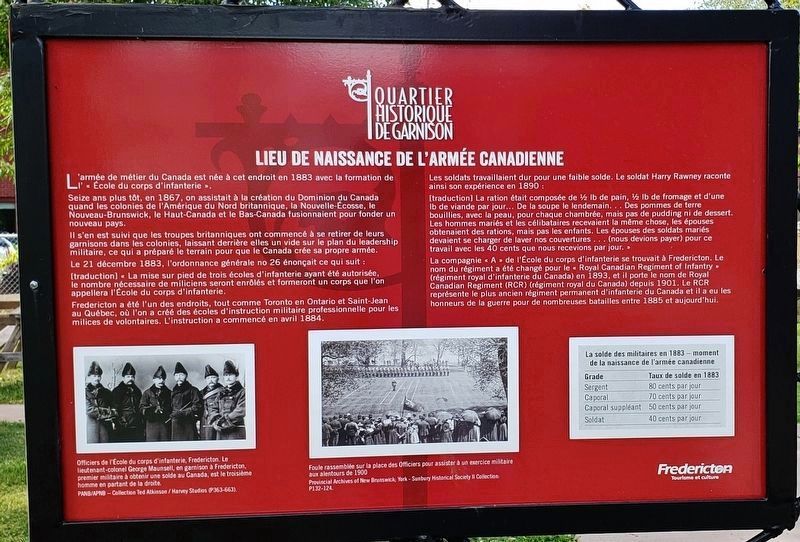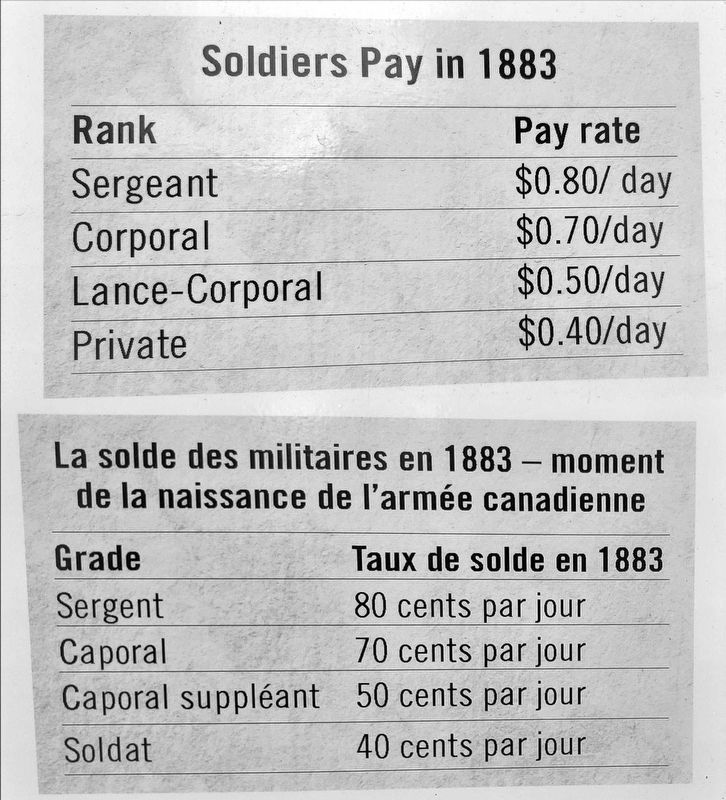Fredericton in York County, New Brunswick — The Atlantic Provinces (North America)
Birthplace of the Canadian Army
Lieu de naissance de l'Armée canadienne
Canada's professional army was born on this site, here in Fredericton in 1883, with the formation of the Infantry School Corps.
Sixteen years prior, in 1867, the Dominion of Canada was formed when the colonies of British North America, Nova Scotia, New Brunswick, Upper Canada and Lower Canada joined together to create a new country. Consequently, British troops began withdrawing from their garrisons in the colonies, creating a vacuum of military leadership and paving the way for Canada to create its own army.
On December 21, 1883 General Order No. 26 stated: "The formation of three schools of infantry having been authorized, the requisite number of Militiamen will be enrolled, and formed into one Corps, to be known as the Infantry School Corps."
Fredericton was one of three locations, along with Toronto, Ontario and Saint Jean, Quebec, to create schools of professional military instruction for the volunteer militia. Training began in April 1884.
Soldiers worked hard for little pay. Private Harry Rawney wrote of his experiences in 1890:
"For rations we got ½ lb. of bread, ½ lb. of cheese and a pound of meat per day… soup the next day… potatoes with their skins on boiled for each room, but no puddings or dessert. Married men and single got the same, the wives received rations but not the children. Our blankets (were) washed by the wives of the married soldiers… (we paid) for the work out of our $0.40 per day."
Fredericton was home to the Infantry School Corps "A" Company. The regiment's name changed to The Royal Canadian Regiment of Infantry in 1893, then to today's Royal Canadian Regiment (RCR) in 1901. The RCR is Canada's oldest permanent force infantry regiment, earning many battle honours from 1885 until today.
L'armée de métier du Canada est née à cet endroit en 1883 avec la formation de l’ « Ecole du corps d'infanterie ».
Seize ans plus tôt, en 1867, on assistait à la création du Dominion du Canada quand les colonies de l'Amérique du Nord britannique, la Nouvelle-Écosse, le Nouveau-Brunswick, le Haut-Canada et le Bas-Canada fusionnaient pour fonder un nouveau pays.
Il s'en est suivi que les troupes britanniques ont commencé à se retirer de leurs garnisons dans les colonies, laissant derrière elles un vide sur le plan du leadership militaire, ce qui a préparé le terrain pour que le Canada crée sa propre armée.
Le 21 décembre 1883, l'ordonnance générale no 26 énonçait ce qui suit : [traduction] « La mise sur pied de trois écoles d'infanterie ayant été autorisée, le nombre nécessaire de miliciens seront enrôlés et formeront un corps que l'on appellera l'École du corps d'infanterie. »
Fredericton a été l'un des endroits, tout comme Toronto en Ontario et Saint-Jean au Québec, où l'on a créé des écoles d'instruction militaire professionnelle pour les milices de volontaires. L'instruction a commencé en avril 1884.
Les soldats travaillaient dur pour une faible solde. Le soldat Harry Rawney raconte ainsi son expérience en 1890 :
[traduction] « La ration était composée de ½ lb de pain, ½ lb de fromage et d'une lb de viande par jour… De la soupe le lendemain… Des pommes de terre bouillies, avec la peau, pour chaque chambrée, mais pas de pudding ni de dessert. Les hommes mariés et les célibataires recevaient la même chose, les épouses obtenaient des rations, mais pas les enfants. Les épouses des soldats mariés devaient se charger de laver nos couvertures… (nous devions payer) pour ce travail avec les 40 cents que nous recevions par jour. »
La compagnie « A » de l'École du corps d'infanterie se trouvait à Fredericton. Le nom du régiment a été changé pour le « Royal Canadian Regiment of Infantry » (régiment royal d'infanterie du Canada) en 1893, et il porte le nom de Royal Canadian Regiment (RCR) (régiment royal du Canada)
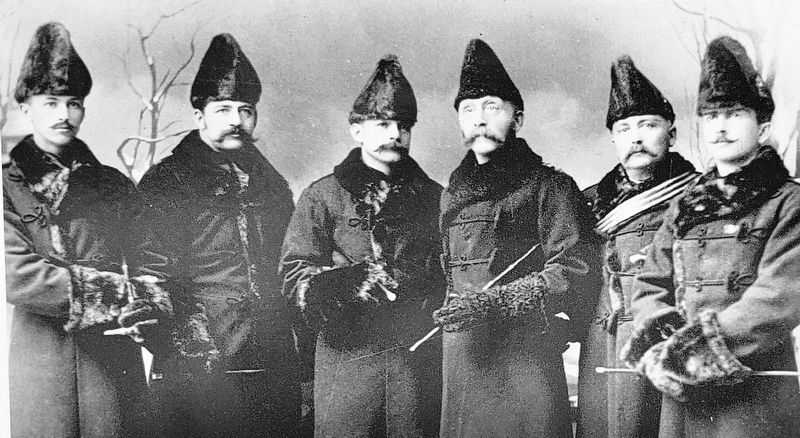
PANB/APNB Ted Atkinson Harvey Studios Collection P363-663
3. Marker detail: Officers of the ISC School /
Officiers de l’École du corps d’infanterie
Officiers de l’École du corps d’infanterie
• • •
(Le lieutenant-colonel George Maunsell, en garnison à Fredericton, premier militaire à obtenir une solde au Canada, est le troisième homme en partant de la droite.)
Erected by Fredericton Tourism and Culture/Tourisme et culture de Fredericton.
Topics. This historical marker is listed in this topic list: Military. A significant historical date for this entry is December 21, 1883.
Location. 45° 57.707′ N, 66° 38.37′ W. Marker is in Fredericton, New Brunswick, in York County. Marker can be reached from Queen Street (New Brunswick Route 102) west of Sainte Anne's Point Drive, on the right when traveling west. Marker is located at the Officers' Square Provincial Heritage Site, on the south side of the Fredericton Region Museum. Touch for map. Marker is at or near this postal address: 571 Queen Street, Fredericton NB E3B 5C8, Canada. Touch for directions.
Other nearby markers. At least 8 other markers are within walking distance of this marker. Juliana Horatia (Gatty) Ewing (here, next to this marker); Epic Winter March of New Brunswick Soldiers in the War of 1812 (here, next to this marker); Charles Rainsford's Brave Rescue (here, next to this marker); Anatomy of the Guard (here, next to this marker); New Brunswick's 104th Regiment of Foot (within shouting distance of this marker); The Right Honourable William Maxwell Lord Beaverbrook
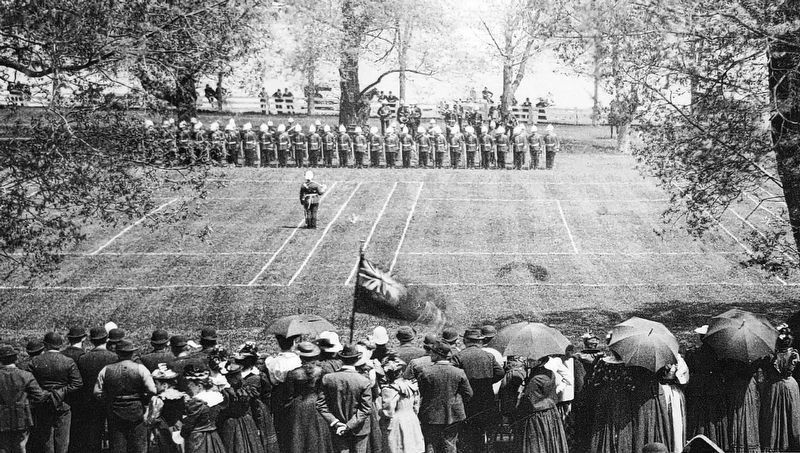
Provincial Archives of New Brunswick; York - Sunbury Historical Society II Collection: P132-124
4. Marker detail: Officer’s Square / place des Officiers
• • •
(Foule rassemblée sur la place des Officiers pour assister à un exercice militaire aux alentours de 1900.)
More about this marker. South side of marker in English; north side of marker in French • Côté sud du marqueur en anglais; côté nord du marqueur en français
Also see . . .
1. The Royal Canadian Regiment. Wikipedia entry:
The Royal Canadian Regiment (The RCR) is an infantry regiment of the Canadian Army. The regiment consists of four battalions, three in the Regular Force and one in the primary reserve. The RCR is ranked 9th in the order of precedence amongst Canadian Army regiments, but is the most senior infantry regiment that has regular force battalions. The RCR was originally authorized as the Infantry School Corps on 21 December 1883. (Submitted on July 7, 2020, by Cosmos Mariner of Cape Canaveral, Florida.)
2. The Royal Canadian Dragoons. Wikipedia entry:
The Royal Canadian Dragoons (RCD) is the senior armoured regiment of the Canadian Army. It is one of three armoured regiments in the Regular Force and forms part of the Royal Canadian Armoured Corps. The colonel-in-chief of The RCD is Charles, Prince of Wales. Formed on December 21, 1883 as the Cavalry School Corps, The Royal Canadian Dragoons is the senior cavalry regiment in the Canadian Army and was Canada's first professional, full-time cavalry unit. (Submitted on July 7, 2020, by Cosmos Mariner of Cape Canaveral, Florida.)
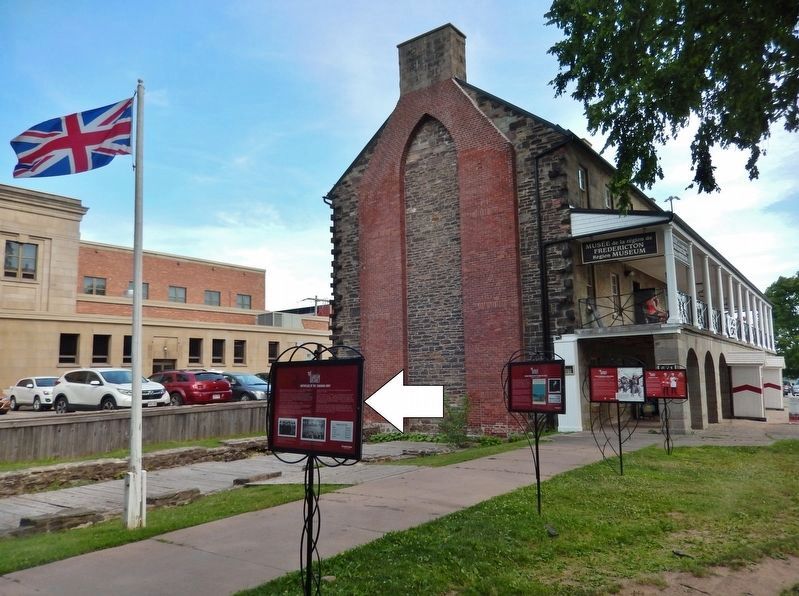
Photographed By Cosmos Mariner, July 30, 2019
6. Birthplace of the Canadian Army Marker
• • •
(Musée de la région de Fredericton en arrière-plan)
"History of the Canadian Army"
Canadians at War website entry
Click for more information.
Credits. This page was last revised on December 17, 2023. It was originally submitted on July 5, 2020, by Cosmos Mariner of Cape Canaveral, Florida. This page has been viewed 138 times since then and 10 times this year. Photos: 1, 2, 3, 4, 5, 6. submitted on July 7, 2020, by Cosmos Mariner of Cape Canaveral, Florida.
